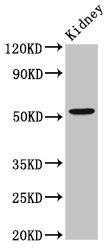Full Product Name
Rabbit anti-Homo sapiens (Human) ZFP36L2 Polyclonal antibody
Alternative Names
BRF2 antibody; Butyrate response factor 2 antibody; C3H1 type-like 2 antibody; EGF response factor 2 antibody; EGF-response factor 2 antibody; ERF 2 antibody; ERF-2 antibody; ERF2 antibody; Protein TIS11D antibody; RNF162C antibody; TIS11D antibody; TISD_HUMAN antibody; ZFP36 like 2 antibody; ZFP36 ring finger protein like 2 antibody; ZFP36-like 2 antibody; Zfp36l2 antibody; Zinc finger protein 36 antibody; Zinc finger protein 36, C3H type like 1 antibody; zinc finger protein 36, C3H type like 2 antibody; Zinc finger protein 36, C3H1 type like 2 antibody; Zinc finger protein, C3H type, 36 like 2 antibody
Species Reactivity
Human, Rat
Immunogen
Recombinant Human mRNA decay activator protein ZFP36L2 protein (219-321AA)
Immunogen Species
Homo sapiens (Human)
Conjugate
Non-conjugated
The ZFP36L2 Antibody (Product code: CSB-PA026450LA01HU) is Non-conjugated. For ZFP36L2 Antibody with conjugates, please check the following table.
Available Conjugates
| Conjugate |
Product Code |
Product Name |
Application |
| HRP |
CSB-PA026450LB01HU |
ZFP36L2 Antibody, HRP conjugated |
ELISA |
| FITC |
CSB-PA026450LC01HU |
ZFP36L2 Antibody, FITC conjugated |
|
| Biotin |
CSB-PA026450LD01HU |
ZFP36L2 Antibody, Biotin conjugated |
ELISA |
Purification Method
>95%, Protein G purified
Concentration
It differs from different batches. Please contact us to confirm it.
Buffer
Preservative: 0.03% Proclin 300
Constituents: 50% Glycerol, 0.01M PBS, pH 7.4
Tested Applications
ELISA, WB
Recommended Dilution
| Application |
Recommended Dilution |
| WB |
1:500-1:5000 |
Storage
Upon receipt, store at -20°C or -80°C. Avoid repeated freeze.
Lead Time
Basically, we can dispatch the products out in 1-3 working days after receiving your orders. Delivery time maybe differs from different purchasing way or location, please kindly consult your local distributors for specific delivery time.
Usage
For Research Use Only. Not for use in diagnostic or therapeutic procedures.







